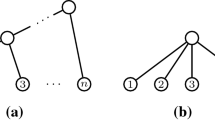Summary
The method of linear invariants discovered by Lake is a way of inferring phylogenies by testing statistical hypotheses. The main advantage of the method is that substitution rates for positions along the DNA sequence do not have to be identical. The assumptions and the algebraic background necessary for the applications of the method were clearly laid out in two papers by Cavender, who also described a way to derive a basis for the space of all linear invariants for rooted trees linking four species when the substitution process satisfies the assumption of balanced transversions. Cavender noted a generalization of linear invariants to certain more general substitution models. In this paper we give a simple explicit description of a basis for all linear invariants for a slight variant of Cavender's more general model, which applies to rooted trees linking any number of species. Bases for rooted trees linking five species are enumerated and the method applied to a problem concerning RNA polymerase sequence data.
Similar content being viewed by others
References
Barry D, Hartigan JA (1987) Statistical analysis of hominoid molecular evolution. Stat Sci 2:191–210
Bellman R (1970) Introduction to matrix analysis, ed 2. McGraw-Hill, New York
Cavender JA (1989) Mechanized derivation of linear invariants. Mol Biol Evol 6:301–316
Cavender JA (1991) Necessary conditions for the method of inferring phylogeny by linear invariants. Math Biosci 103:69–75
Evans SN, Speed TP (1992) Invariants of some probability models used in phylogenetic inference. Ann Stat (in press)
Felsenstein J (1981) Evolutionary trees from DNA sequences: a maximum likelihood approach. J Mol Evol 17:368–376
Felsenstein J (1989) Phylogenetic inference programs (PHYLIP) manual, version 3.2. University of Washington, Seattle
Fox GE, Stackenbrandt E, Hespell RB, Gibson J, Maniloff J, Dyer JA, Wolf RS, Balch WE, Tanner RS, Magrum LJ, Zahlen LB, Blakemore R, Gupta R, Bonen L, Lewis BJ, Stahl DA, Luehrsen KR, Chen KH, Woese CR (1980) The phylogeny of prokaryotes. Science 209:457–463
Good IJ (1965) The estimation of probabilities: an essay on modern Bayesian methods. MIT Press, Cambridge MA
Hasegawa M, Kishino H, Yano T (1985) Dating of the humanape splitting by a molecular clock of mitochondrial DNA. J Mol Evol 22:160–174
Jukes TH, Cantor C (1969) Evolution of protein molecules. In: Munro HN (ed) Mammalian protein metabolism. Academic Press, New York, pp 21–132
Kimura M (1980) A simple method for estimating evolutionary rates of base substitution through comparative studies of nucleotide sequences. J Mol Evol 16:111–120
Kimura M (1981) Estimation of evolutionary sequences between homologous nucleotide sequences. Proc Natl Acad Sci USA 78:454–458
Kimura M (1983) The neutral theory of molecular evolution. Cambridge University Press, Cambridge
Lake JA (1987) A rate-independent technique for analysis of nucleic acid sequences: evolutionary parsimony. Mol Biol Evol 4:167–191
Navidi W, Churchill GA, von Haeseler A (1991) Methods for inferring phylogenies from nucleic acid sequence data by using maximum likelihood and linear invariants. Mol Biol Evol 8: 128–143
Navidi W, Churchill GA, von Haesler A (1992) Phylogenetic inference: linear invariants and maximum likelihood. Biometrics (in press)
Neyman J (1971) Molecular studies of evolution: a source of novel statistical problems. In: Gupta SS, Yackel J (eds) Statistical decision theory and related topics. Academic Press, New York, pp 1–27
Olsen GJ (1987) Earliest phylogenetic branchings: comparing rRNA-based evolutionary trees inferred with various techniques. Cold Spring Harbor Symp Quant Biol 52:825–837
Sidow A, Wilson AC (1990) Compositional statistics: an improvement of evolutionary parsimony and its application to deep branches of the tree of life. J Mol Evol 31:51–68
Swofford DL, Olsen GJ (1990) Phylogeny reconstruction. In: Hillis DM, Moritz C (eds) Molecular systematics. Sinauer Associates, Sunderland MA, pp 411–501
Tavaré S (1986) Some probabilistic and statistical problems in the analysis of DNA sequences. In: Miura R (ed) Lectures on mathematics in the life sciences. American Mathematical Society, Providence RI, pp 57–86
Woese CR (1987) Bacterial evolution. Microbiol Rev 51:221–271
Author information
Authors and Affiliations
Additional information
Offprint requests to: T.P. Speed
Rights and permissions
About this article
Cite this article
Nguyen, T., Speed, T.P. A derivation of all linear invariants for a nonbalanced transversion model. J Mol Evol 35, 60–76 (1992). https://doi.org/10.1007/BF00160261
Received:
Accepted:
Issue Date:
DOI: https://doi.org/10.1007/BF00160261




